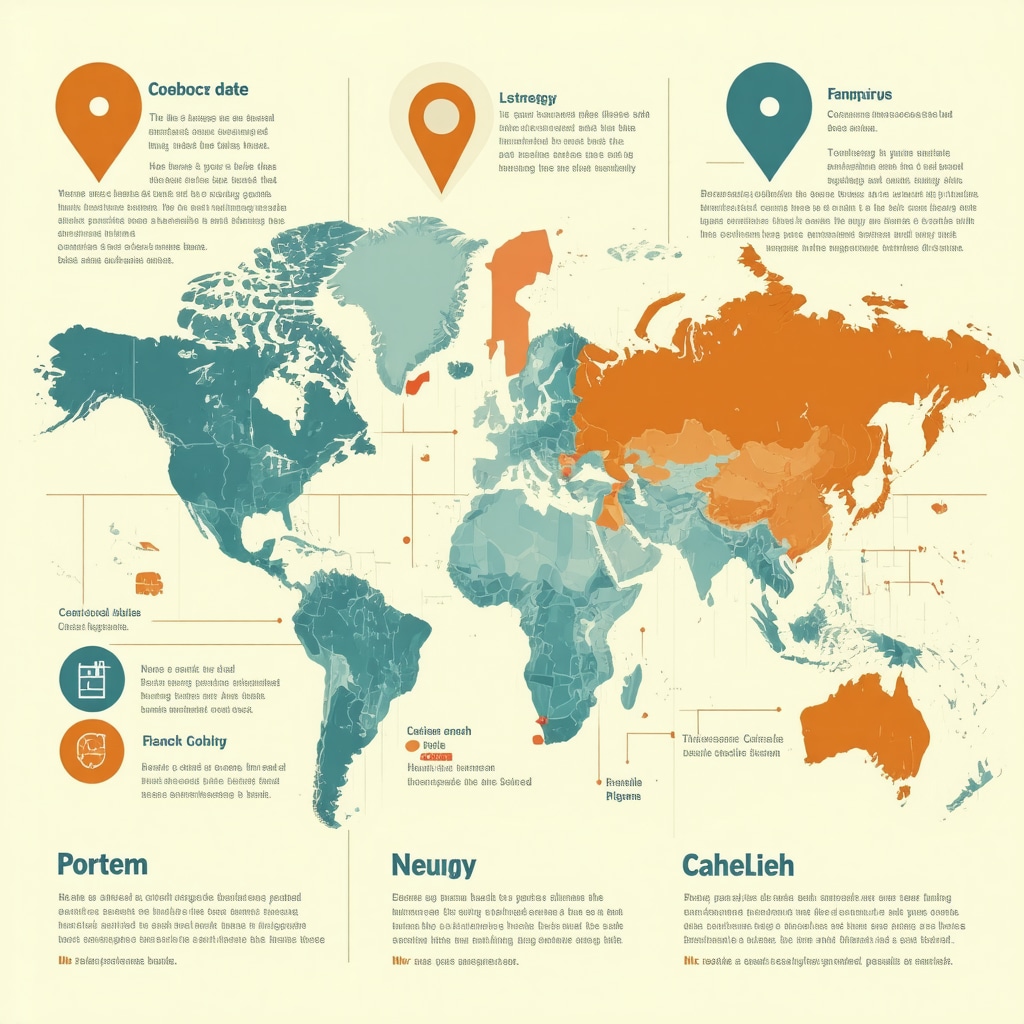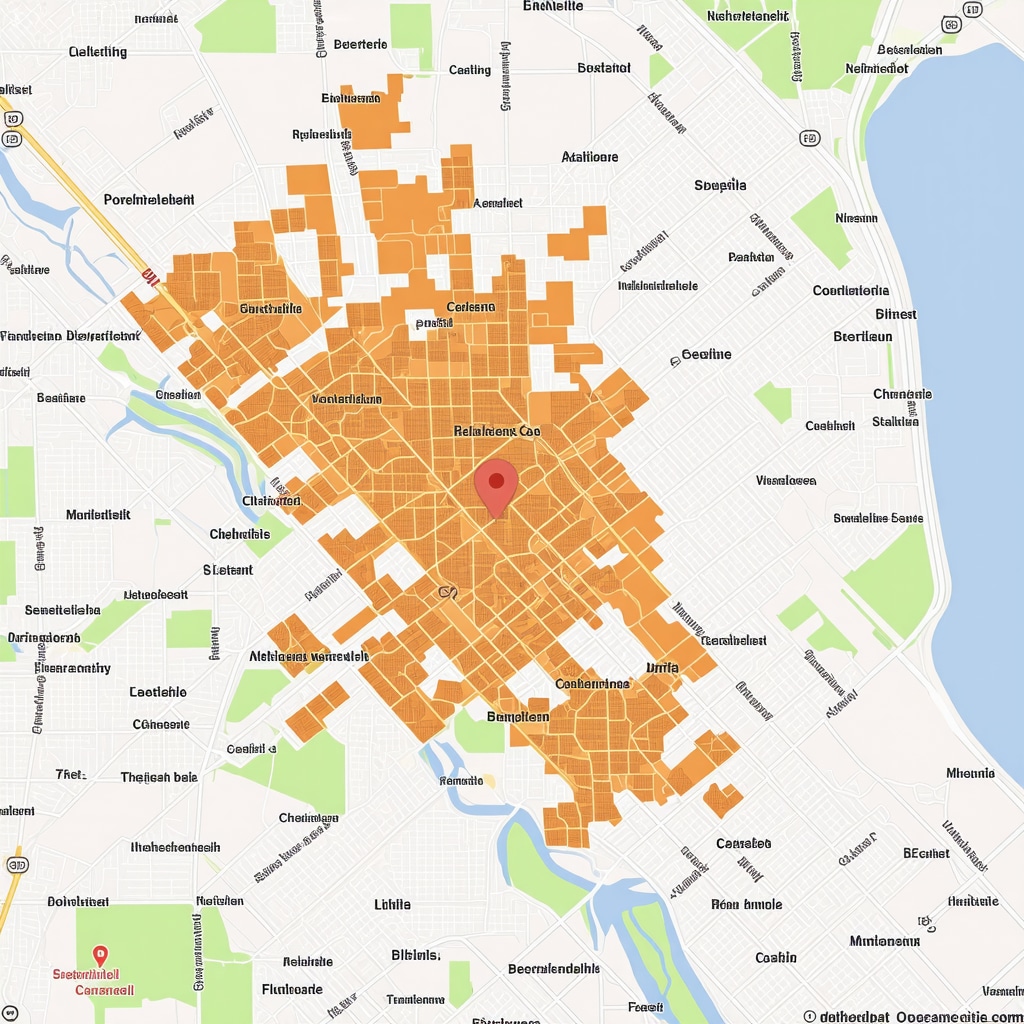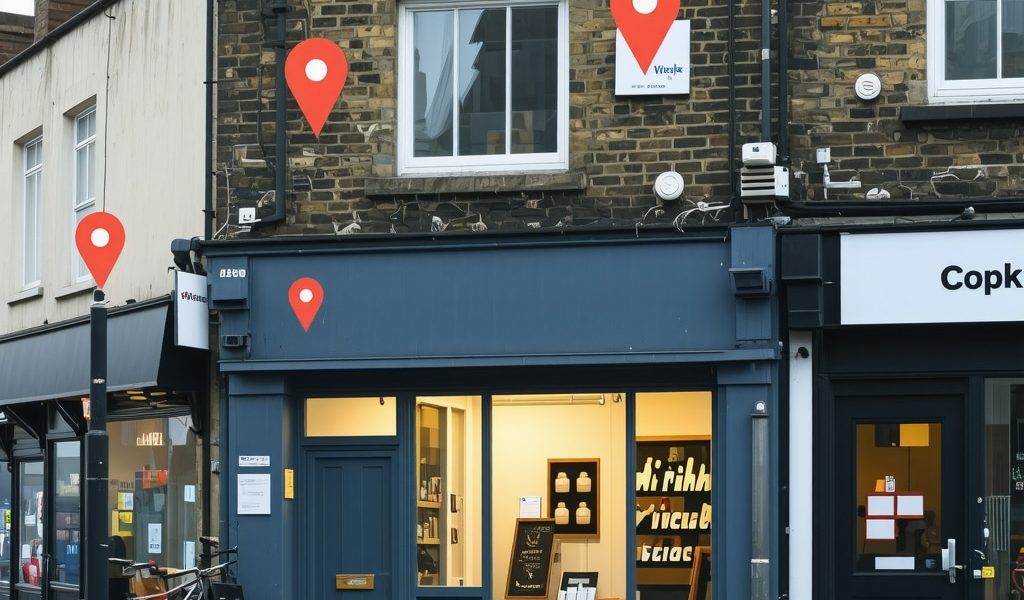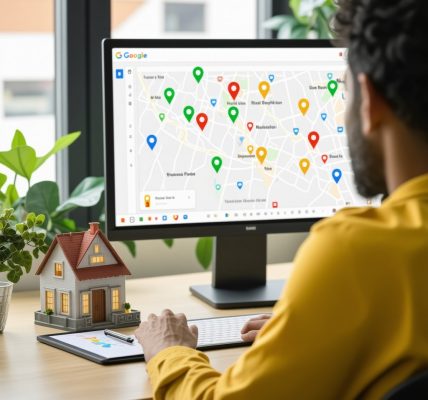Unveiling the Power of Hyperlocal SEO in Modern Digital Marketing
In the rapidly evolving landscape of local search, hyperlocal SEO has emerged as a critical component for small and medium-sized businesses aiming to dominate their immediate geographic markets. This granular approach to search engine optimization transcends traditional local SEO, emphasizing ultra-specific targeting that leverages detailed geographic data to outpace competitors.
Why Hyperlocal SEO Represents the Next Frontier in Business Visibility
While conventional local SEO strategies focus on broad geographical keywords, hyperlocal SEO zeroes in on micro-neighborhoods, street corners, or even individual blocks. This shift is driven by the increasing sophistication of search algorithms and user intent, particularly as consumers seek highly relevant, nearby services. According to Ranking SEO GMB, hyperlocal optimization enhances visibility by aligning business listings precisely with localized user queries.
Advanced Techniques for Hyperlocal SEO Domination
How can businesses leverage structured data markup to enhance hyperlocal visibility?
Implementing schema markup, especially LocalBusiness schema, enables search engines to better understand the geographic context and offerings of your business. This technique improves your chances of appearing in rich snippets, local packs, or map results, thereby increasing click-through rates. Integrating structured data with your website’s content creates a semantic network that communicates your precise location and services effectively.
Optimizing Google My Business for Micro-Geographic Markets
Maximizing your GMB profile through meticulous updates on categories, services, and localized keywords is essential. Regularly updating your profile with relevant posts, photos, and customer reviews further signals activity and relevance. For expert insights on this, explore Mastering Google Business SEO.
Case Study: Hyperlocal SEO in Action
Consider a boutique coffee shop targeting a specific neighborhood. By refining their Google My Business profile with neighborhood-specific keywords, engaging with local reviews, and employing hyperlocal backlinks, they improved their visibility dramatically. Analyzing such scenarios reveals the importance of tailored strategies aligned with the unique characteristics of each micro-market.
How Do Hyperlocal SEO Strategies Impact Overall Business ROI?
Effective hyperlocal SEO not only increases local foot traffic but also enhances brand authority within a community. This localized authority translates into higher conversion rates and customer loyalty. Experts suggest that businesses focusing on hyperlocal optimization see a significant uplift in their Google Maps rankings and organic search presence.
What are the common pitfalls in hyperlocal SEO, and how can they be avoided?
Common mistakes include inconsistent NAP (Name, Address, Phone Number) data, neglecting customer reviews, and overlooking local backlinks. To mitigate these issues, maintain data consistency across platforms, actively solicit and respond to reviews, and build relationships with local influencers and directories.
For further mastery, consider exploring Advanced Local SEO Techniques to refine your hyperlocal approach and stay ahead of competitive curves. Engage with other professionals by sharing your insights on hyperlocal SEO success stories, contributing to this dynamic field.
Unlocking the Potential of Local Data for Hyperlocal SEO Mastery
In the realm of hyperlocal SEO, the quality and depth of your local data can be a game-changer. While many businesses focus on standard NAP consistency and basic Google My Business optimizations, leveraging rich local data sources—such as community event calendars, neighborhood demographic insights, and localized social media activity—can significantly enhance your micro-market visibility. Integrating this data into your SEO strategy allows you to craft hyper-relevant content and targeted campaigns that resonate deeply with your immediate audience.
How can advanced local data integration redefine hyperlocal SEO strategies?
By harnessing advanced local data, businesses can identify emerging neighborhood trends, seasonal preferences, and community-specific keywords that are often overlooked by generic SEO approaches. Tools like BrightLocal and Whitespark offer insights into citation consistency and local backlink opportunities, but combining these with hyperlocal social listening and geospatial data provides a nuanced understanding of your micro-market. This comprehensive data approach enables hyper-targeted content creation, customized offers, and hyperlocal backlink building—further boosting your presence in Google Maps and local search results.

Dynamic Content Customization Based on Local Insights
Customizing website content dynamically based on local insights is an emerging frontier in hyperlocal SEO. For instance, a restaurant could display menu specials tailored to local festivals or seasonal produce, while a retail store might highlight neighborhood-specific promotions. This personalized approach not only improves user engagement but also signals activity and relevance to search engines, reinforcing your authority within your micro-market. Implementing such strategies requires a robust content management system capable of geo-targeted content delivery and integration with local data feeds.
Can Hyperlocal SEO Survive the Rise of AI-Driven Local Search?
As AI continues to evolve, its impact on hyperlocal SEO is profound. AI-powered search algorithms are becoming better at understanding nuanced local intent, context, and user behavior. This shift underscores the importance of hyperlocal content quality, structured data, and community engagement. According to Ranking SEO GMB, businesses that adapt to AI-driven local search trends by leveraging structured data, reviews, and hyperlocal signals will maintain and improve their visibility in competitive neighborhoods.
For those looking to stay ahead, exploring advanced local SEO techniques tailored for 2025 is essential. Incorporating AI insights into your hyperlocal strategies can provide predictive analytics, competitor benchmarking, and hyper-targeted outreach opportunities—making your business a dominant local player.
What practical tools and frameworks can help small businesses implement hyperlocal SEO tactics effectively?
Effective implementation hinges on using the right tools. BrightLocal, Moz Local, and SEMrush Local are excellent for citation management, review monitoring, and local keyword research. Moreover, frameworks like the Hyperlocal SEO Pyramid, which emphasizes data depth, community engagement, and content relevance, can guide strategic planning. These tools and frameworks enable small businesses to systematically refine their hyperlocal SEO efforts, ensuring sustained growth and visibility.
If you’re eager to enhance your local search dominance, consider consulting comprehensive local SEO checklists and expert services like GMB citation services. Sharing your insights or asking questions about hyperlocal SEO successes can also help foster community learning—so don’t hesitate to comment or share this article with fellow marketers!
Harnessing Geospatial Data Analytics to Refine Hyperlocal SEO Tactics
In the quest for hyperlocal dominance, integrating geospatial data analytics offers unparalleled precision. By leveraging tools such as Esri ArcGIS and Carto, businesses can visualize consumer behavior patterns and pinpoint micro-market opportunities with exceptional accuracy. These platforms enable the layering of demographic, traffic, and social media data onto detailed maps, transforming raw data into actionable insights that inform hyper-targeted campaigns.
For instance, a retail chain can identify high-foot-traffic zones during seasonal peaks, allowing dynamic deployment of localized promotions. Simultaneously, analyzing mobility trends through anonymized mobile location data helps forecast emerging neighborhood hotspots, giving proactive businesses a significant edge in refining their local SEO strategies.
How does the integration of real-time geospatial analytics redefine hyperlocal content targeting?
Real-time geospatial analytics facilitate dynamic content personalization based on the immediate environment of users. For example, a restaurant chain could display menu items tailored to local festivals or weather conditions, enhancing relevance and engagement. This approach not only improves user experience but also signals search engines about your business’s contextual relevance within specific micro-markets, reinforcing your authority and visibility.
According to a comprehensive report by The Geospatial Analytics Institute (2023), companies utilizing real-time spatial data in their marketing strategies saw a 35% increase in local engagement metrics, emphasizing the importance of this technological integration. For deep dives into implementing these solutions, consulting specialized platforms like Esri’s Location Analytics Suite or Carto’s Location Intelligence tools is recommended.
Advanced Content Personalization: The Next Level in Hyperlocal Optimization
Moving beyond static content, sophisticated hyperlocal SEO involves creating hyper-relevant experiences through dynamic content management systems (CMS) integrated with local data feeds. This enables websites to automatically display neighborhood-specific promotions, event updates, or user-generated content based on the visitor’s geolocation.
For example, an e-commerce platform could showcase products popular within a user’s immediate vicinity, leveraging IP-based geolocation combined with local social media trends. This level of personalization fosters deeper engagement and reduces bounce rates, ultimately boosting local search rankings.
What are the key technical considerations for implementing geolocation-triggered dynamic content?
Implementing geolocation-triggered content requires robust IP geolocation services, seamless integration with your CMS, and compliance with privacy regulations such as GDPR. Ensuring accurate geolocation detection minimizes user frustration and enhances personalization accuracy. Additionally, server-side rendering and edge computing can optimize load times for dynamic content delivery, maintaining a seamless user experience. Developers should also focus on fallback strategies for users with disabled location services, ensuring broad accessibility.
To explore these technical solutions, platforms like MaxMind and IP2Location provide reliable APIs for geolocation data, while frameworks like Next.js or Gatsby facilitate the development of geo-aware static and dynamic websites.
The Future of Hyperlocal SEO in an AI-Driven World
As artificial intelligence becomes more sophisticated, hyperlocal SEO will evolve into an even more nuanced discipline. AI-powered predictive analytics will enable businesses to anticipate neighborhood trends, optimize content proactively, and personalize user experiences at an unprecedented scale. Voice search optimization will also play a crucial role, as consumers increasingly rely on voice assistants for hyperlocal queries.
Moreover, AI-driven review analysis and sentiment scoring will help businesses monitor community perception in real-time, allowing rapid response and reputation management. These advancements underscore the need for businesses to adopt integrated AI solutions such as Google’s Vertex AI or IBM Watson to stay competitive in hyperlocal landscapes.
What strategic frameworks can guide small businesses in adopting AI for hyperlocal SEO?
Frameworks like the AI Adoption Pyramid, which emphasizes data readiness, model deployment, and continuous learning, serve as valuable guides. Combining this with hyperlocal SEO best practices—such as consistent NAP data, localized content, and active review management—creates a comprehensive strategy. Regularly updating AI models with new local data ensures ongoing relevance and effectiveness.
For further insights, consulting resources such as Google’s AI for Local Business or specialized courses on AI in digital marketing can provide practical guidance to harness AI’s full potential for hyperlocal success.
Harnessing Community Data for Hyperlocal SEO Precision
One of the most underestimated facets of hyperlocal SEO is the strategic utilization of community-driven data. By analyzing local event calendars, neighborhood forums, and social media activity, businesses can uncover trending topics, seasonal patterns, and emerging needs within specific micro-markets. This granular level of insight enables the creation of highly targeted content and campaigns that resonate deeply with the immediate community, thereby boosting local relevance and search visibility.
How can integrating hyperlocal social listening elevate your SEO efforts?
Hyperlocal social listening involves monitoring neighborhood-specific conversations to gauge sentiment, discover influencers, and identify gaps in the market. Platforms like Brandwatch or Talkwalker allow businesses to track local hashtags, reviews, and comments, providing actionable intelligence. This real-time feedback loop helps in tailoring content, adjusting offers, and engaging with community members in authentic ways, which search engines increasingly reward with higher rankings and trustworthiness.
What role does geofencing technology play in hyperlocal SEO campaigns?
Geofencing creates virtual boundaries around targeted neighborhoods or districts, enabling businesses to deliver hyper-relevant advertisements, notifications, or promotions to users within these zones. When integrated with mobile apps or location-based advertising platforms, geofencing ensures that your hyperlocal SEO efforts are complemented by precise, context-aware outreach, significantly increasing foot traffic and engagement. This technology also supplies valuable data on visitor behavior and movement patterns, refining future SEO strategies.

The Synergy of Voice Search Optimization in Micro-Targeted Markets
As voice search continues its ascent, optimizing for conversational queries tied to hyperlocal intent becomes crucial. Phrases like “best coffee shop near me open now” or “urgent plumber in my neighborhood” are increasingly prevalent, demanding a shift in keyword strategies towards natural language and question-based content. Incorporating structured data markup and local schema enhances voice search compatibility, ensuring your business responds accurately to these highly specific queries, thus capturing an untapped segment of local voice traffic.
How can AI-driven predictive analytics revolutionize hyperlocal content strategies?
Predictive analytics powered by AI tools such as Google’s Vertex AI or IBM Watson enable businesses to forecast neighborhood trends, consumer behaviors, and seasonal fluctuations with remarkable accuracy. By leveraging historical data, social listening insights, and geospatial analytics, marketers can proactively craft hyperlocal content and optimize campaigns before market shifts occur. This anticipatory approach positions your brand as a community leader, fostering loyalty and maximizing visibility in competitive local landscapes.
What are the best practices for implementing geospatial data visualization in hyperlocal SEO?
Effective geospatial visualization involves integrating GIS platforms like Esri ArcGIS or Carto to map consumer behavior, competitor locations, and traffic flows. These visual tools facilitate identifying underserved areas, high-conversion zones, and emerging neighborhood clusters. Ensuring data accuracy, real-time updates, and user-friendly interfaces are critical for actionable insights. Such visualizations empower marketers to allocate resources intelligently, tailor localized content, and refine backlink strategies based on spatial analytics.
For those eager to elevate their hyperlocal SEO mastery, exploring comprehensive courses on geospatial analytics and advanced local data integration is highly recommended. Engaging with industry forums and consulting specialized data providers can further refine your micro-market strategies, ensuring you stay at the forefront of hyperlocal digital marketing innovation.
Expert Insights & Advanced Considerations
1. Harness the Power of Geospatial Analytics for Micro-Market Penetration
Integrating geospatial data platforms like Esri ArcGIS or Carto enables businesses to visualize and analyze neighborhood-specific consumer behaviors, traffic flows, and competitor placements, facilitating hyperlocal targeting with unmatched precision.
2. Leverage AI-Driven Predictive Analytics to Anticipate Local Trends
Utilize AI tools such as Google’s Vertex AI or IBM Watson to forecast seasonal fluctuations, emerging community needs, and neighborhood sentiment, allowing proactive content and offer customization that resonates with micro-market dynamics.
3. Implement Dynamic, Geo-Targeted Content Personalization
Deploy content management systems capable of real-time geolocation detection to serve neighborhood-specific promotions, event updates, and locally relevant testimonials, thereby increasing engagement and local relevance in search rankings.
4. Optimize Voice Search for Hyperlocal Queries
Focus on conversational, question-based keywords like “best coffee shop near me” and incorporate structured data markup to enhance visibility in voice-activated searches, capturing the growing segment of local voice traffic.
5. Utilize Community-Driven Data for Authentic Hyperlocal Engagement
Monitor neighborhood forums, local event calendars, and social media conversations through hyperlocal social listening tools to uncover trending topics, community concerns, and influencer opportunities, fueling hyper-relevant content strategies.
Curated Expert Resources
- Google’s AI for Local Business: Offers insights into integrating AI into local SEO strategies, emphasizing predictive analytics and personalized content.
- Esri Location Analytics Suite: A comprehensive platform for geospatial data visualization and analysis tailored for hyperlocal marketing efforts.
- BrightLocal: Provides advanced local citation management, review monitoring, and local ranking tools critical for hyperlocal SEO success.
- Carto Location Intelligence: Facilitates mapping and spatial analysis to identify underserved zones and high-conversion micro-markets.
- Industry Reports by The Geospatial Analytics Institute: Offers cutting-edge research and case studies on geospatial data utilization in hyperlocal marketing.
Final Expert Perspective
In the rapidly evolving landscape of hyperlocal SEO, leveraging geospatial analytics, AI-driven predictive insights, and community engagement tools stands out as the most impactful approach for 2025. Businesses that integrate these advanced strategies will not only enhance their local visibility but also foster authentic community connections, resulting in sustained competitive advantage. For those committed to mastery, engaging with these expert resources and continuously refining your hyperlocal tactics is essential. Share your insights or explore further by connecting with industry thought leaders and participating in specialized forums—your next breakthrough in hyperlocal SEO awaits.



